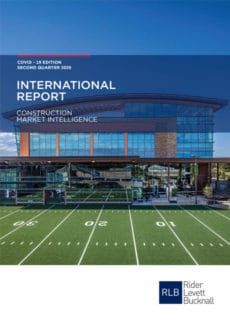According to Rider Levett Bucknall’s (RLB) 2nd Quarter 2020 International Report, construction markets across the globe have been adversely impacted by this year’s COVID-19 pandemic.
Since March 2020, countries across the globe have been responding to the COVID-19 pandemic by balancing the need to ‘flatten the curve’ with maintaining an appropriate level of economic activity across the country.
RLB Director, Domenic Schiafone said, ‘The construction industry and associated supply chains were deemed “essential industries” in some countries/states and have continued to operate, whereas in others, full site shutdowns caused the industry to hibernate.’
He added, ‘As industries across the globe awaken, our offices across North America, The United Kingdom, North and South Asia, Australia, New Zealand, South Africa and The Middle East are seeing a muted pipeline of future projects commencing. In the recent RLB COVID-19 Global Survey (July 2020) over two thirds of respondents are foreseeing a period of at least nine months required for activity to return to normal in their local market.’
Striking a balance between economic and human outcomes
This path to ‘normal’ however is at the present time mostly predicated on the achievement of a scientifically-based outcome for containing the virus globally. Striking a balance between economic and human outcomes is a challenging exercise, and finding an acceptable landing spot based upon health in the population, weighed against the return of economic stability, is the current focus of most governments around the world.
There are more and more examples from around the globe of the effects of reopening economies too early, with resulting virus flare-ups and hotspots which are causing ‘off again / on again’ community impacts.
Many nations are facing economic challenges unseen before now. Most countries are seeing significant surges in unemployment, and where there have been job support schemes in place, the enormous consequences of ending these schemes is yet to be seen.
Market volatility the leading issue to be faced
Domenic continued, ‘With construction long being seen as a staple in governments’ range of tools to stimulate economic recovery, there is evidence that this will again be the case. As economies relax the economic, social and workplace constraints that have been implemented, we see market volatility as the leading issue to be faced in all regions with differing effects on project costs.’
‘This volatility will be fuelled by the potential flattening of projects out to tender, supply chain movements, longer initial project gestation, site productivity, conservative contractor risk acceptance, and fluctuations in both labour and material availability.
Most of our offices have identified a fall in construction escalation during 2020, but in these uncertain times, the only real constant is change itself,’ he concluded.
South Africa
It is difficult to speculate on what will happen with the TPI movement after the ban on construction activity is lifted. Before the lockdown the inflation rate was already low, with equal or even lower tender rates than those received during 2019.
If there is a quick uptake of new work across all sectors (public as well as private), contractors will most likely try to make up losses in earnings of previous years, with the resultant spike in tender prices. That is however unlikely due to the lack of capital for new projects.
The government promised a cash injection for the industry, which is most likely for infrastructure, where the civil engineering industry may profit. The prime lending rate has been cut by 2.50% since the start of the lockdown, which will help the economy in the short term.
Saudi Arabia
COVID-19 is likely to have a long-standing effect on current and future construction projects due to two main factors; disruptions to previously stable supply chains and the limited mobility of labour.
Saudi Arabia has a long history of importing goods for use in construction. Two of the largest importers have been Italy and China, both at the epicentre of the recent pandemic. In addition, the closure of borders has prevented the movement of materials, and more worrying is the potential closure of businesses due to COVID-19.
Q2 2020 in Riyadh has seen a downturn in previously forecast TPI figures, due to two main factors; the ongoing volatility of oil prices and the COVID-19 pandemic. Saudi Arabia’s budget is based primarily on the oil markets (the 2030 Vision plan focuses on diversifying away from this reliance).
There has been a significant downturn in oil prices and global demand in 2020 as a result of both COVID-19 and the OPEC nation’s oil price dispute.
With the oil price dropping over 40% from Q2 2019, the Saudi Arabian Government is reviewing the 2020 budget for all state-funded construction projects.
North Asia
The uncertainty in the global economy stemming from the COVID-19 outbreak will deteriorate construction investment in private sectors with shrinking construction activities in the next few quarters, and contractors are expected to become more competitive in submitting tenders.
In the first quarter of 2020, the price of steel and cement in Shanghai fell by 7% and 4% respectively compared with the previous quarter; the price of reinforcement and ready-mixed concrete in Shenzhen fell by 11% and 8% respectively over the same period. TPI of major cities in China were generally in downward trends in the first half of 2020 amid a competitive material supply market.
In Hong Kong and Macau, the downward trend of tender prices will continue, resulting from a slowdown in construction activities with the setback in private construction investment locally, and the rising unemployment rate in the construction industry.
As South Korea has a strong domestic investment base and a rising commercial property market, construction activities may not shrink as significantly as other cities within the region and a mild upward trend is forecast for TPI movement in 2020.
South Asia
Singapore TPI movement is expected to be negligible for the second quarter of 2020, as tenders are few and far between since the start of the pandemic.
TPI for the second half of the year is projected to see an increment of 2 to 5 per cent due to: (a) an anticipated overhaul of the foreign worker dormitories arrangements and conditions resulting in increased overheads, (b) new work flows, physical distancing measures and housekeeping practices when construction sites re-open and (c) supply chain and plant and equipment disruptions and delays as economies worldwide re-open in varying degrees.
Over the last 2-3 months in Malaysia, tenders which were supposed to be called have been delayed due to the MCO and CMCO in the prevention of the COVID-19 pandemic. As such, there has been a lack of cost data to verify TPI movements to date. However, we foresee that the TPI will fall due to a scarcity of projects in the market and fierce competition among contractors struggling to stay afloat.
We also believe that uncertainties in employment and business stability will cause demand for properties to drop drastically, which will invariably affect developers’ confidence to build. Developers are currently adopting a wait-and-see approach on the health of the economy before proceeding with sale launches of buildings.
North America
Unemployment in the United States construction industry is currently at 16.6 per cent, much higher than the national average and up from 6.9 per cent in March of this year. Across America, the COVID-19 outbreak has had differing impacts across the country. As each state differs in classifying what is deemed essential and non-essential work, state and local governments have had mixed responses.
Australia
With falling demand across the board predicted, Brisbane is forecasting zero uplift to tender pricing for 2020, Townsville 0.5% and Perth 1.5%. Melbourne is forecasting a drop to 2.0% whereas Sydney remains at 3.5% for 2020.
The current consensus across RLB offices is that the general inputs into construction costs are generating a number of opposing factors. The reducing construction volumes are likely to increase competition and reduce margins. However, volatile exchange rates, supply chain reliability and changing work practices, resulting in lower productivity potentially increasing program durations, are all likely to increase costs.
New Zealand
Prior to COVID-19 the forecast TPI was typically around 2-3% which is more in-line with general CPI, but slightly above. The forecast now, post-COVID-19, is varied across the regions.
In Auckland, it is already apparent that the market has reduced margins to secure work in the short term, as several planned projects have either been deferred or mothballed and the forecast TPI movement is now -5% for the 2020 year.
The Wellington market is much smaller than Auckland, and to date there has been lesser immediate impact on the construction market and no impact on TPI, although this is expected to change over the next few months.
Christchurch is forecasting a slight TPI increase of 0.5% for 2020, down from 2%, with reasonable activity still planned, primarily in the health and education sectors.
United Kingdom
Given the dual concerns of COVID-19 and Brexit, the industry’s tendering market has had to cope with multiple influences, upward and downward.
Issues of prospective shortages of skilled and unskilled labour forecast for next year, when European workers may be less readily available, have been upstaged by current site closures, where socially-distanced working has not been possible.
Where sites are open, productivity has been adversely affected, and materials’ availability called into question, as producers and distributors have likewise been affected by the same constraints faced by the sites.
Looking at the wider business environment, construction clients are themselves struggling to cope with understanding what a post-COVID-19 world looks like, with total orders likely to reduce. Overall, contractors’ estimators have to estimate their input costs, while directors have to balance how to apply overheads costs and profit to win work – an unenviable task in a world awash with uncertainty in ways no-one has ever experienced before.
Europe
The COVID-19 experience has been widely variable in Europe, with the many countries in the region coping in widely diverging ways. The first effects were seen in Italy, but before long, they had spread to the whole of Europe.
Throughout, the construction industry has experienced shutdowns and re-openings, with the introduction of social-distancing measures. Wherever possible, sites have remained open, as construction is seen to be a major contributor in almost all economies.
All cities, apart from Moscow, are forecasting a drop in overall pricing through 2020 from that forecast at the end of 2019. In relation to tender price movements, there are competing effects in most markets across Europe.



